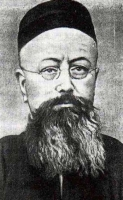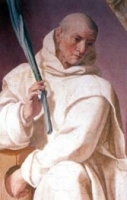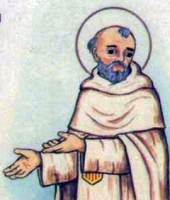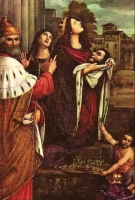தூய ரோமுவால்ட் (ஜூன் 19)
ரோமுவால்ட், இத்தாலியில் உள்ள ரவென்னாவில் 951 ஆம் ஆண்டு ஒரு செல்வச் செழிப்பான குடும்பத்தில் பிறந்தார். இவர் தன்னுடைய சிறு வயதில் எந்தவொரு கவலையும் இல்லாமல் சந்தோசமாக வாழ்ந்து வந்தார்.
இப்படிப்பட்ட சூழ்நிலையில் இவருடைய தந்தை, பக்கத்து வீட்டுக்காரரோடு இருந்த சொத்துத் தகராறில் அவரைக் கொன்றுபோட்டுவிட்டார். கொன்றுபோட்டதோடு மட்டுமல்லாமல், தனக்கு ஏதாவது ஆபத்து நேர்ந்துவிடுமோ என்று உயிருக்குப் பயந்து தலைமறைவானார். இதை நேரில் கண்ட ரேமுவால்ட் மனம் வருந்தினார். தன்னுடைய தந்தை செய்த தவற்றிற்கு பிராயச்சித்தம் செய்ய நினைத்தார். எனவே இவர் தூய ஆசிர்வாதப்பர் சபையில் சேர்ந்து துறவியாக வாழத் தொடங்கினார்.
சில காலம் அங்கிருந்து பயிற்சிகள் பெற்று துறவியாக வாழ்ந்து வந்த ரேமுவால்ட்டிற்கு மடத்தில் பின்பற்றப்பட்ட விதிமுறைகள் பிடிக்கவில்லை. அவை மிகவும் தளர்வாக இருக்கின்றன என்பதை உணர்ந்த இவர் மரினுஸ் என்பவரிடத்தில் சென்று பயிற்சி பெறத் தொடங்கினார்.
இதற்கிடையில் இவர் பல்வேறு நாடுகளுக்குச் சென்று நற்செய்தி அறிவிக்கவேண்டும் என்றெல்லாம் திட்டம் தீட்டினார். ஆனால் ஒவ்வொருமுறையும் இவர் ஒவ்வொரு நாட்டிற்கும் நற்செய்தி அறிவிக்கச் செல்லும்போது ஏதாவது ஒரு நோய் தாக்கி, அங்கு போகமுடியாத சூழ்நிலை ஏற்பட்டது. இதனால் இவர் அயல்நாடுகளுக்குச் சென்று நற்செய்தி அறிவிப்பது தனக்குச் சரிப்படாது என நினைத்து கமல்டோலி என்னும் இடத்தில் துறவற மடம் ஒன்றை நிறுவி அங்கே கடுந்தவம் செய்து, ஜெபத்தில் தன்னை முழுமையாய் ஈடுபடுத்தத் தொடங்கினார்.
இப்படி ஜெப தவ வாழ்க்கையில் தன்னை முழுமையாய் ஈடுபடுத்திக்கொண்டு வாழ்ந்துகொண்டிருக்கின்ற சமயத்தில், முன்னர் சொத்துத் தகராறில் பக்கத்து வீட்டுக்காரரைக் கொன்றுபோட்டுவிட்டு ஓடிப்போன ரேமுவால்ட்டின் தந்தை மனம் வருந்தி அவருடைய சபையில் வந்து சேர்ந்து நல்லதொரு துறவியாக வாழத் தொடங்கினார்.
இப்படி எல்லாமும் நன்றாகப் போய்க்கொண்டிருந்த சமயத்தில் திடிரென ஒருநாள் ரேமுவால்ட் நோய்வாய்ப்பட்டு படுத்த படுக்கையாகி. 1027 ஆம் ஆண்டு இறையடி சேர்ந்தார். இவருக்கு 1595 ஆம் ஆண்டு புனிதர் பட்டம் கொடுக்கப்பட்டது.
june 19
Birth: 950
Death: 1027
St. Romuald was born at Ravenna about the year 956. In spite of an infinite desire for virtue and sanctity, his early life was wasted in the service of the world and its pleasures. Then one day, obliged by his father, Sergius, to be present at a duel fought by him, he beheld him slay his adversary. The crime made such an impression upon him that he determined to expiate it for forty days, as though it were entirely his own. For this purpose he retired to a Benedictine monastery of St. Apollinare, near Ravenna, where he became Abbot. After founding several monasteries, he laid the foundations of the austere Order of Camaldoli in Tuscany. Like all the saints, he fought a lifelong battle against the assaults of devils and men. In the beginning of his spiritual life he was strongly assailed by numerous temptations, which he conquered by vigilance and prayer. More than one attempt was made on his life, but Divine Providence enabled him to escape from the danger. Like many servants of God, he also became the victim of calumny, which he bore in patience and silence. In his old age, he increased his austerities instead of diminishing them. After a long life of merit, he died in the monastery of Castro, which he founded in Marquisate of Ancona. His death occurred on June 19, about the year 1027. His feast day is June 19th.
"Saint Romuald" redirects here. For the community, see Saint-Romuald, Quebec.
Romuald (Latin: Romualdus; c. 951 – traditionally 19 June, c. 1025/27 AD)[1] was the founder of the Camaldolese order and a major figure in the eleventh-century "Renaissance of eremitical asceticism".[2] Romuald spent about 30 years traversing Italy, founding and reforming monasteries and hermitages.
Life
According to the vita by Peter Damian,[3] written about fifteen years after Romuald's death,[2] Romuald was born in Ravenna, in northeastern Italy, to the aristocratic Onesti family. His father was Sergius degli Onesti and his mother was Traversara Traversari. As a youth, according to early accounts, Romuald indulged in the pleasures and sins of the world common to a tenth-century nobleman. At the age of twenty he served as second to his father, who killed a relative in a duel over property. Romuald was devastated, and went to the Basilica of Sant'Apollinare in Classe to do 40 days of penance.[4] After some indecision, Romuald became a monk there. San Apollinare had recently been reformed by St. Mayeul of Cluny Abbey, but still was not strict enough in its observance to satisfy Romuald. His injudicious correction of the less zealous aroused such enmity against him that he applied for, and was readily granted, permission to retire to Venice, where he placed himself under the direction of a hermit named Marinus and lived a life of extraordinary severity.[5]
San Romualdo, from the San Marco altarpiece by Fra Angelico (Minneapolis Institute of Arts)
About 978, Pietro Orseolo I, Doge of Venice, who had obtained his office by acquiescence in the murder of his predecessor, began to suffer remorse for his crime. On the advice of Guarinus, Abbot of Saint-Michel-de-Cuxa, in Catalonia, and of Marinus and Romuald, he abandoned his office and relations, and fled to Cuxa, where he took the habit of St. Benedict, while Romuald and Marinus erected a hermitage close to the monastery.[5] Romuald lived there for about ten years, taking advantage of the library of Cuxa to refine his ideas regarding monasticism.[6]
After that he spent the next 30 years going about Italy, founding and reforming monasteries and hermitages.[4] His reputation being known to advisors of the Holy Roman Emperor Otto III, Romuald was persuaded by him to take the vacant office of abbot at Sant'Apollinare to help bring about a more dedicated way of life there. The monks, however, resisted his reforms, and after a year, Romuald resigned, hurling his abbot's staff at Otto's feet in total frustration. He then again withdrew to the eremetical life.
In 1012 he arrived at the Diocese of Arezzo. Here, according to the legend, a certain Maldolus, who had seen a vision of monks in white garments ascending into Heaven, gave him some land, afterwards known as the Campus Maldoli, or Camaldoli. St. Romuald built on this land five cells for hermits, which, with the monastery at Fontebuono, built two years later, became the famous mother-house of the Camaldolese Order.[5] Romuald's daunting charisma awed Rainier of Tuscany, who was neither able to face Romuald nor to send him away.[7] Romuald founded several other monasteries, including the monastery of Val di Castro, where he died in 1027.
Romuald's feast day was not included in the Tridentine Calendar. It was added in 1594 for celebration on 19 June, the date of his death, but in the following year it was transferred by Pope Clement VIII to 7 February, the anniversary of the transfer of his relics to Fabriano in 1481, and in 1969 it was moved back to the day of his death.[8]
In San Romualdo, painted for the Church of San Romualdo, Ravenna, by Guercino, 1641, an angel uses the abbot's baton to chastise an errant figure (Pinatoceca Comunale, Ravenna).
St. Romuald's Rule
In his youth Romuald became acquainted with three major schools of western monastic tradition. Sant'Apollinare in Classe was a traditional Benedictine monastery under the influence of the Cluniac reforms. Marinus followed a much harsher, ascetic and solitary lifestyle, which was originally of Irish eremitic origins. The abbot of Sant Miguel de Cuxa, Guarinus, had also begun reforms but mainly built upon a third Christian tradition, that of the Iberian Peninsula. Romuald was able to integrate these different traditions and establish his own monastic order. The admonition in his rule Empty yourself completely and sit waiting places him in relation to the long Christian history of intellectual stillness and interior passivity in meditation also reflected in the nearly contemporary Byzantine ascetic practice known as Hesychasm.
Sit in your cell as in paradise. Put the whole world behind you and forget it. Watch your thoughts like a good fisherman watching for fish. The path you must follow is in the Psalms — never leave it.[9]
If you have just come to the monastery, and in spite of your good will you cannot accomplish what you want, take every opportunity you can to sing the Psalms in your heart and to understand them with your mind. And if your mind wanders as you read, do not give up; hurry back and apply your mind to the words once more.[9]
Archbishop Cosmo Francesco Ruppi noted that, "Interiorization of the spiritual dimension, the primacy of solitude and contemplation, slow penetration of the Word of God and calm meditation on the Psalms are the pillars of Camaldolese spirituality, which St. Romuald gives as the essential core of his Rule."[10]
Romuald's reforms provided a structural context to accommodate both the eremitic and cenobitic aspects of monastic life
St. Didier
Feastday: June 19
Deodatus was a native of Gaul and known in France as Die' and Didier. He became bishop of Nevers about 655, attended the synod of Sens in 657, and several years later resigned his See to become a hermit, at first in the Vosges, and when driven out by the inhabitants, on an island near Strasbourg, which later developed into the famous monastery of Ebersheim. He later returned to the Vosges and founded a monastery, Jointures, of which he became abbot and remained there till his death. His feast day is June 19th.
St. Ursicinus of Ravenna
Feastday: June 19
Death: 67
Martyred physician. According to his unreliable Acts, he was a physician in Ravenna condemned for being a Christian during the persecution of Emperor Nero. His faith began to waver, but he found new strength through the encout agement of St. Vital is and met his death with resolve.
Saint Ursicinus of Ravenna (Italian: Sant' Ursicino) (d. ca. 67) is venerated as a martyr by the Catholic Church. He was said to be a physician of Ravenna. His legend is connected with that of Saint Vitalis, who is said to have encouraged the wavering Ursicinus after the physician was sentenced to death for his faith. After he was beheaded, Vitalis buried him in Ravenna.[1]
He should not be confused with Bishop Ursicinus of Ravenna (6th century), who ordered the Basilica of Sant'Apollinare in Classe to be built.
Saint Rémi Isoré
Also known as
Rémigius Isoré
Additional Memorial
• 28 September as one of the 120 Martyrs of China
• 4 February (Jesuits)
Profile
Eldest son in a pious family. His father taught primary school, one brother became a priest, one sister joined the Daughters of Saint Vincent de Paul. Remigious felt a call to the priesthood from an early age. Entered Saint Francis School in 1865 at age 13, and the seminary at Cambrai, France in 1871 at 19. Taught primary school at Roubaix, France in 1873 at age 21. In 1876 at age 24 he entered the Jesuit novitiate at Saint Acheul, and was soon assigned to teach high school at La Providence. Beginning in 1881, he felt a call to missionary work, and was assigned to work in China. He arrived in Xian, Hebei in 1882, and spent a year learning Chinese. Ordained on 31 July 1886 at the Xian Cathedral. Taught at the public school in Zhangjiazhuang. Dean of the school at Guangpingfu. Parish priest of Zhoujiazhuang, Wei Country. Martyred during the Boxer Rebellion.
Born
22 January 1852 in Bambeque, France
Died
• 19 June 1900 in Wuyi, Hebei, China while praying at the altar
• head hung outside the village as a warning to other Catholics
Canonized
1 October 2000 by Pope John Paul II
Saint Juliana Falconieri
Also known as
Giuliana Falconieri
Profile
Only child of a wealthy Florentine noble family of Chiarissimo and Riguirdata Falconieri. Niece of Saint Alexis Falconieri. Her father died Juliana was very young, and her uncle Alexis had a great influence on her. Given to chronic gastric problems throughout her life. Legend says she never gazed into a mirror, never looked at a man's face, trembled at the mention of sin, and fainted upon hearing scandalous gossip.
Juliana refused an arranged marriage at age 14. She became a Servite tertiary in 1285, taking the habit from her spiritual director, Saint Philip Benizi. Helped form, and served as first superior of the Servite Order of Mary (Servite Nuns, the Mantellate Servites), which was formally established in 1304, and their first convent founded in 1305.
At her death, unable to receive Holy Communion because of constant vomiting, she requested the priest to spread a corporal upon her breast and lay the Host on it. Soon after, the Host disappeared, Juliana died, and the image of the cross that had been on the Host was found on her breast.
Born
1270 at Florence, Italy
Died
• 12 June 1341 at Florence, Italy of natural causes
• relics at the church of San Annunziata in Florence
Beatified
26 July 1678 by Pope Innocent XI
Canonized
16 June 1737 by Pope Clement XII
Patronage
against sickness; sick people
Saint Modeste Andlauer
Additional Memorial
9 July as one of the Martyrs of China
Profile
Eighth son of Joseph Andlauer, a baker, and Françoise Barbe Bisch. Baptized on 23 May 1847 at the church of Saints Peter and Paul, in Rosheim, France. Studied at the Episcopal College of Saint-Etienne in Strasbourg, France. Joined the Jesuits in October 1872 in Saint-Acheul, France. Ordained in Arras, France on 22 September 1877. Taught German at colleges in the French cities of Amiens, Lille and Brest. Missionary to China, arriving on 22 November 1882. He learned the languages of the region, served in several locations, worked with Saint Rémi Isoré, and became Head of Mission in Weishein (Wei Xian), China. Murdered during the anti-Western, anti-Christian persecutions of the Boxer Rebellion when a armed mob stormed the village and executed anyone who admitted to being Catholic. Martyr.
Born
22 May 1847 in Rosheim, Bas Rhin, diocese of Strasbourg, France
Died
• 19 June 1900 in Wuyi, Hebei, China while praying at the altar
• head hung outside the village as a warning to other Catholics
Canonized
1 October 2000 by Pope John Paul II
Blessed Sebastian Newdigate
Additional Memorial
4 May as one of the Carthusian Martyrs
Profile
Younger son of John Newdigate, a king's sergeant, and Amphelys, daughter and heiress of John Nevill of Sutton, Lincolnshire, a pious family; his sister became a Dominican nun at the Dartford, England convent. Studied at Cambridge University. Married layman, and father of one daughter named Amphelys. Widower in 1524. Priest. Privy counselor to King Henry VIII. Carthuisian monk in the London Charterhouse. When given the Oath of Succession, accepting Henry VIII's supremacy over the Church in England, he signed it on 6 June 1534, adding the note "in as far as the law of God permits" to the document to indicate his conditional agreement. Arrested on 25 May 1535 with many brother monks for loyalty to Rome. Imprisoned in chains at Marshalsea Prison, and later in the Tower of London. Executed with Blessed Humphrey Middlemore and Blessed William Exmew. Martyr.
Born
Harefield, Middlesex, England
Died
hanged, drawn, and quartered on 19 June 1535 at Tyburn, London, England
Beatified
29 December 1886 by Pope Leo XIII
Saint Gervase
Also known as
Gervasius, Gervasio
Profile
Second century martyr. Son of Saint Vitalis of Milan and Saint Valeria of Milan. He and his beheaded twin brother Protase are considered the first martyrs of Milan as Saint Ambrose, guided by a vision, unearthed their remains in 386. Saint Paulinus of Nola says the martyrs appeared to Saint Ambrose in an apparition. Even when the relics were discovered, nothing was remembered about them except their names and that they were martyrs in an early persecution, perhaps under Nero. The surviving Acts of Gervase are worthless as biography as ancient writers invented details to fill in the missing details.
Died
beaten to death with a lead-tipped whip c.165
Patronage
• for the discovery of thieves
• haymakers
• archdiocese of Perugia-Città della Pieve, Italy
• 5 cities
Blessed Thomas Woodhouse
Profile
Priest in Lincolnshire, England. Forced to resign due state persecution, he became a tutor in Wales. Arrested and sent to Fleet Prison on 14 May 1561 for the crime of celebrating Mass. He lay there for nine years before being tried and convicted for his faith. At some point during his incarceration he joined the Jesuits, and he ministered to fellow prisoners when possible.
On 19 November 1572 he convinced the prison washer-woman to take a letter to Lord Burghley. In it he begged that Burghley seek reconciliation with Rome, and convince Elizabeth to do the same. He followed up this by writing more letters and papers, signing them, tying them to rocks, and throwing them from his window into the street in hopes that passersby would spread his message. He was soon transferred to Newgate prison, and a few weeks later, executed. Martyr.
Born
1535 in Lincolnshire, England
Died
hanged, drawn, and quartered on 19 June 1573 at Smithfield, London, England
Beatified
29 December 1886 by Pope XIII (cultus confirmation)
Saint Protase
Also known as
Protasio, Protasius
Profile
Second century martyr. Son of Saint Vitalis of Milan and Saint Valeria of Milan. He and his twin brother Gervase are considered the first martyrs of Milan as Saint Ambrose, guided by a vision, unearthed their remains in 386. Saint Paulinus of Nola says the martyrs appeared to Saint Ambrose in an apparition. Even when the relics were discovered, nothing was remembered about them except their names and that they were martyrs in an early persecution, perhaps under Nero.
Died
beheaded c.165
Patronage
• for the discovery of thieves
• haymakers
• archdiocese of Perugia-Città della Pieve, Italy
• 5 cities
Blessed William Exmew
Additional Memorial
4 May as one of the Carthusian Martyrs
Profile
Studied at Christ's College, Cambridge; noted classical scholar. Carthusian monk at the London Charterhouse. Vicar of the house, working with Blessed John Houghton. Procurator of the house in 1534; his vicar was Blessed Humphrey Middlemore. On 6 May 1535 the two were denounced as traitors for loyalty to the pope. They and Blessed Sebastian Newdigate were arrested, chained to posts in Marshalsea prison for several days, then transfered to the Tower of London. The three, with Blessed John Fisher, were tried for treason on 11 June 1535, and when they insisted that the pope was the head of the Church, were all condemned to death. Martyr.
Born
English
Died
hanged, drawn and quartered on 19 June 1535 at Tyburn, London, England
Beatified
9 December 1886 by Pope Leo XIII
Blessed Odo of Cambrai
Also known as
• Odo of Orléans
• Odoardus...
Profile
One of the most learned French scholars of the 11th century. Layman headmaster of the cathedral school at Tournai in 1087. Following a close study of the writings of Saint Augustine of Hippo, around 1090 he felt a calling to religious life. Benedictine monk. He founded a Benedictine community at the disused abbey of Saint Martin at Tournai. Bishop of Cambrai, France in 1105. When he refused lay investiture, asserting that only the Church has authority over such decisions, he was exiled to the abbey of Anchin.
Born
1050 at Orleans, France
Died
19 June 1113 at Anchin, France of natural causes
Saint Nazario of Koper
Profile
Bishop of Koper (in modern Slovenia) c.524 where he served for 30 years.
Born
c.475 in Elpidium (Böste)
Died
• c.555
• buried in the cathedral of Saint Mary
• due to Lombard invaders, his relics were placed in a case, stored under some stone steps, and it's location forgotten for centuries
• miracles reported with their re-discovery
• relics stolen in 1380 when the city was plundered in the War of Chioggia
• relics returned in 1422
• relics enshrined in a marble altar sarcophagus in the cathedral of Koper
Patronage
Koper, Slovenia
Blessed Humphrey Middlemore
Additional Memorial
4 May as one of the Carthusian Martyrs
Profile
Carthusian monk at the London Charterhouse. Priest. Procurator on the London Charterhouse. When he refused to recognize the validity of King Henry VIII's marriage with Anne Boleyn, he was imprisoned and martyred with two brother monks for treason.
Died
hanged, drawn and quartered on 19 June 1535 at Tyburn, London, England
Beatified
20 December 1886 by Pope Leo XIII
Saint Deodatus of Nevers
Also known as
Adeodate, Didier, Die, DieuDonne, Donato
Profile
Monk. Founder of Ebersheimmunster, near Strasbourg, France, served as its first abbot. Bishop of Nevers, France c.655. Attended the synod of Sens in 657. Founded Valde-Galilee-Jointures Abbey c.660. Late in life he retired to live as a prayerful hermit in the Vosges.
Born
Gaul (modern France)
Died
c.679 of natural causes
Saint Lambert of Saragossa
Also known as
Lamberto, Lambertus
Profile
Farmer and servant during the period of Muslim occupation of Spain. Martyred by his Saracen master.
Died
• beheaded c.900
• jawbone enshrined in Maastricht, Netherlands
• monastery named for his was built on the trditional site of his execution in 1522; it was destroyed in 1808
Blessed Arnaldo of Liniberio
Profile
Mercedarian prior in Barcelona, Spain. Ransomed 156 Christians in Morocco and 32 in Granada, Spain who had been enslaved by Muslims.
Died
• of natural causes
• buried near the altar of the church of his convent in Barcelona, Spain
Saint Hildegrin of Chalons
Also known as
Hildegrin of Werden
Profile
Younger brother of Saint Ludger of Utrecht. Worked with Ludger to evangelize the Saxons. Bishop of Chalons-sur-Marne, France in 802. In later life he retired to live as a Benedictine monk at Werden Abbey in Germany, where he was later elected its abbot.
Died
c.827 of natural causes
Saint Adleida and Saint Lupo of Bergamo
Profile
Parents of Saint Grata of Bergamo. Converts. Martyrs.
Saint Deodatus of Jointures
Also known as
Adéodat, Didier, Dieu-Donné, Dié
Profile
Bishop. Founded the monastery of Val-de-Galilée, Jointures, France, and served as its first abbot.
Died
c.680
Saint Gaudentius of Arezzo
Profile
Bishop. Martyred in the persecutions of Valentian I along with 53 companions whose names have not come down to us.
Died
364 at Arezzo, Tuscany, Italy
Saint Culmatius of Arezzo
Profile
Deacon. Martyred in the persecutions of Valentian I along with 53 companions whose names have not come down to us.
Died
364 at Arezzo, Tuscany, Italy
Saint Zosimus of Umbria
Profile
Martyred in the persecutions of Trajan.
Died
beheaded in 110 in Umbria, Italy
Saint Innocent of Le Mans
Profile
Bishop of Le Mans, France for over 40 years.
Died
559















